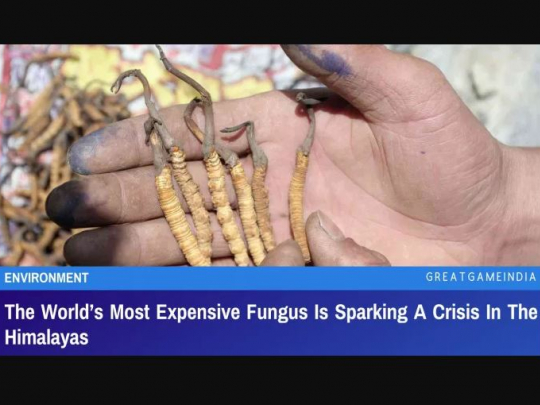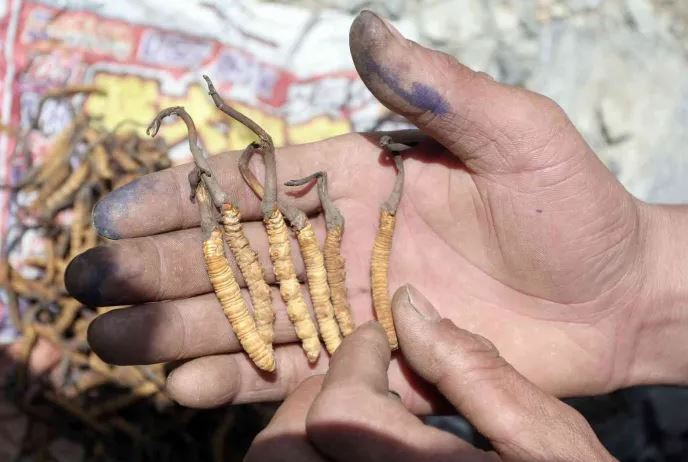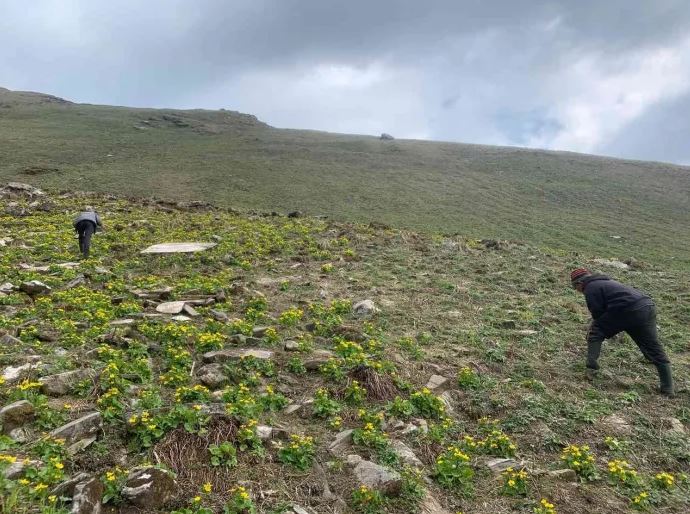The World’s Most Expensive Fungus Is Sparking A Crisis In The Himalayas

 The caterpillar fungus can be found in Bhutan, Nepal, the Indian states of Uttarakhand, Sikkim, and Arunachal Pradesh, as well as nearby high-altitude regions of the Central and Eastern Himalayas. But due to its decline, the world’s most expensive fungus is sparking a crisis in the Himalayas.
The caterpillar fungus can be found in Bhutan, Nepal, the Indian states of Uttarakhand, Sikkim, and Arunachal Pradesh, as well as nearby high-altitude regions of the Central and Eastern Himalayas. But due to its decline, the world’s most expensive fungus is sparking a crisis in the Himalayas.
Devendra Chulkota earned a handsome one lakh rupees in the year he was in class 10.
In the mountain meadows close to his home in Chulkot village, in Uttarakhand’s Pithoragarh district, he learned that there was a thriving market for caterpillar fungus.
Locally called as keeda jadi, the fungus that appears on the head of a dead caterpillar is thought to have aphrodisiac properties. Some people even refer to it as the Himalayan viagra. It is especially sought in China, where it fetches staggering prices, rising from $13,000 to $20,000 per kilogram on the market between 1995 and 2015. According to current exchange rates, its price might range from $20,000 to $40,000 per kilogram, or between Rs 15 lakh and Rs 30 lakh.
According to a 2018 study (read below), “Considered more valuable than gold, China’s capitalist economy has transformed this traditionally valued medicine into a highly prized Guanxi gift.” Guanxi is a term used in Chinese to refer to social networks and connections that help to facilitate business opportunities and deals.
According to the study, it was a particularly well-liked present “for government officials, leaders, or someone generally viewed as superior.”
The fact that Devendra routinely visited the mountain meadows, or bugyals, close to his village in the Munsiyari block gave him an advantage in his search for the fungus. “I used to take sheep to the bugyals for grazing, so I knew the places where keeda jadi could be found,” he said.
He left school after realizing how much money he could make from the fungus. “I had more money than many who had been working for years!”
He was confident that he would be able to make more than Rs 4 lakh annually, which would be a considerable salary for a person living in Chulkot.
He was 16 at the time. He now regrets his choice after ten years. He claimed, “From 2015 onwards, I managed to find fewer and fewer fungus stems.”
Constant deterioration was observed. “This year I found only 100,” he said. This would fetch him only between Rs 10,000 and Rs 20,000, and “won’t even take care of the cost of staying in the bugyal for a month,” he added.
He started working for the taxi owner-driver as an unpaid assistant in 2021. He dreams of owning a taxi one day. “I never thought that I would have to do something like this when I dropped out of school to devote all my attention to collection,” he said.
Caterpillar fungus is believed to have aphrodisiac qualities, and is a highly valued gift in China. It currently sells for between $20,000 and $40,000 in the international market. Photo: Simon Zo/Reuters
The demise of the caterpillar fungus was also mentioned in an article in The Atlantic, which cited studies conducted in Tibet by ecologist Kelly Hopping in the same region where the fungus is prevalent. “By interviewing hundreds of collectors, and analyzing the local climate,” the report stated, “Hopping has conclusively shown what others have suspected: The precious fungus is disappearing, as a result of a double whammy of overharvesting and warming weather. The caterpillar-fungus bubble is ready to burst, and an entire way of life could vanish with it.”
The caterpillar fungus can be found in Bhutan, Nepal, the Indian states of Uttarakhand, Sikkim, and Arunachal Pradesh, as well as nearby high-altitude regions of the Central and Eastern Himalayas. The fungus is collected in India in the Uttarakhand districts of Chamoli and Pithoragarh, where it is present in the greatest concentrations, as well as, on a lesser scale, in Sikkim.
Some moths contract the fungus when they are in the larval, or caterpillar, stage. These larvae hatch from the eggs that adult moths lay in the grass and other vegetation near to the ground. Healthy larvae stay one to two feet underground until they have undergone the moth transformation after hatching. However, when larvae are afflicted, the fungus eats away at their interiors, which, according to researchers, forces them to bore upwards towards the earth as a result of the discomfort and suffering. The fungus grows from a larva’s head by the time it reaches the ground and appears above the surface as a thin, black stem.
The Himalayan snow begins to melt in the spring and summer months of May and June, exposing the land and promoting the emergence of grasses. The entire caterpillar fungus, including the insect’s skeletal remains and the stem that protrudes from it and like a swirling spear, is harvested and used. While its most common usage in traditional Chinese medicine is as an aphrodisiac, it is also thought to have anti-aging effects and to aid in the treatment of cancer as well as digestive, renal, respiratory, and cardiac disorders.
Caterpillar fungus is found in the mountain meadows of the Himalayas. The fungus infects a caterpillar that is underground. It then emerges above ground through the caterpillar’s head. Photo: Ishan Kukreti
In Pithoragarh, keeda jadi collecting began in the middle of the 1990s, although it only recently started in Chamoli. Since Dharchula block borders Nepal, collectors from that block initially started traveling to Munsiyari to gather the fungus because they had heard of the need for it. Residents of Munsiyari claim that these collectors kept their activities and potential earnings a secret from the public.
However, residents were informed of the fungus by goatherds who frequently visited the meadows. “A collector from Dharchula told them and they told us and then there was a rush. Many people started going,” according to Munsiyari collector Laxman Mehra.
According to a study, by 2014, 81 percent of Munsiyari’s residents were actively engaged in the collection effort, and the neighborhood as a whole collected a total of about 88.96 kg of material, valued at about Rs 2.05 crore, every year.
According to the survey, each collector in Munsiyari block earned between US $972 and US $1,485 annually, or between Rs 76,736 and Rs 1,17,237 at the time of writing. Usually, they may pay for this with two months of employment. In contrast, a study found that rural households make an average monthly income of Rs 8,059, or Rs 96,708 yearly.
The villagers who travel there want to spend close to a month—and occasionally even longer—in the meadows. This necessitates a substantial initial expenditure.
Additionally, collectors skip their other jobs to visit the meadows. The months of collection fall with the paddy growing season. Many residents prefer collecting the fungus than cultivating paddy because of the high prices it commands.
The decrease in collection and income for caterpillar fungus collectors can be attributed to a number of interrelated factors. According to a study by Amrita Laha, the anti-corruption policies put in place by Xi Jinping in 2013 that forbade certain gifts, including caterpillar fungus, contributed to the decline in demand from China as well as the rapid increase in the number of people harvesting fungi.
Because there are so many middlemen, collectors have also lost money. When the collecting first began in the middle of the 1990s, most of the visitors to Munsiyari to purchase the fungus were traders from the Dharchula block. There are now a huge number of traders, known as thekedar or contractors, who come directly from the villages and are continuously looking for higher shares of the sales.
The movement of the contractors is a secretive process because a large portion of the commerce is technically unlawful. Police frequently arrest contractors and seize the fungus.
The fall in yields has ecological causes as well. According to Sachin Bohra, who completed a PhD on the fungus at Pithoragarh University and collected environmental data from the collection regions between 2008 and 2019, unchecked human activity has altered the habitat and reduced harvests.
With the exception of a few sheep herders, the bugyals no rarely see many human visitors; instead, they now host hundreds of people for almost two months nonstop. During these months of collection, people require fires to survive, so they cut down trees on the meadows to make them. “These trees acted as barriers between the warmer air of the lower elevation and the colder air of the tops. With this barrier gone, the temperatures are rising,” Bohra said.
This has caused the once-common fungus to become less prevalent at lower elevations. “Earlier it used to be found at 1,500 to 2,000 meters, now you’ll be lucky if you can find it at even 3,000 metres,” Bohra said. “This is because the local temperatures have increased.”
Bohra said that whereas fungus-infected caterpillars and moths were normally found in similar quantities during previous stages of his research, the numbers of moths are currently increasing. “People have also over-extracted the fungus, and therefore the spores aren’t spreading, leading to lower yields,” he added.
- Source : GreatGameIndia




















